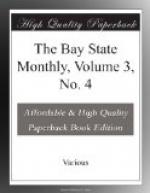The first half of the month of December had worn away. A new governor, Francis W. Pickens, ruled the destinies of South Carolina. A Convention, authorized by the Legislature, met at Columbia, the capital of the State, and, on the 20th of December, passed unanimously what it called an ordinance of secession, in the following words:—
We, the people of the State of South Carolina, in convention assembled, do declare and ordain, and it is hereby declared and ordained, that the ordinance adopted by us in convention on the 23d day of May, in the year of our Lord 1788, whereby the Constitution of the United States of America was ratified, and also all Acts and parts of Acts of the General Assembly of this State ratifying amendments of the said Constitution, are hereby repealed; and that the Union now subsisting between South Carolina and other States, under the name of the United States of America, is hereby dissolved.
The ordinance was immediately made known by huge placards, issued from the Charleston printing-offices, and by the firing of guns, the ringing of bells, and other jubilations. The same evening South Carolina was proclaimed an “independent commonwealth.” Said one of the chief actors: “The secession of South Carolina is not an event of a day. It is not anything produced by Mr. Lincoln’s election, or by the non-execution of the Fugitive-Slave Law. It is a matter which has been gathering head for thirty years.” This was a distinct affirmation, which is corroborated by other and abundant testimony, that the revolt was not only against right, but that it was utterly without cause.
The events which took place in South Carolina were, in substance, duplicated in her sister States of the South. Mississippi seceded on January 9, 1861; Florida, on January 10; Alabama, on January 11; Georgia, on January 18; Louisiana, on January 26; and Texas, on February 1; but not a single State, except Texas, dared to submit its ordinance of secession to a direct vote of the people.
One of the most striking features in the early history of the secession is the apparent delusion in the minds of the leaders that secession could not result in war. Even after the firing upon Sumter, the delusion continued to exist. Misled, perhaps, by the opinion of ex-President Pierce,[1] the South believed that the North would be divided; that it would not fight. It is but fair to say that the tone of a portion of the Northern press, and the speeches of some of the Northern Democrats, and the ambiguous way of speaking on the part of some of the Northern Republicans rather warranted than discouraged such an opinion.
There was, however, one prominent man from Massachusetts, who had united with the Southern leaders in the support of Breckenridge, who had wisdom as well as wit, and who now sought to dispel this false idea. In the month of December he was in Washington, and he asked his old associates what it meant.




